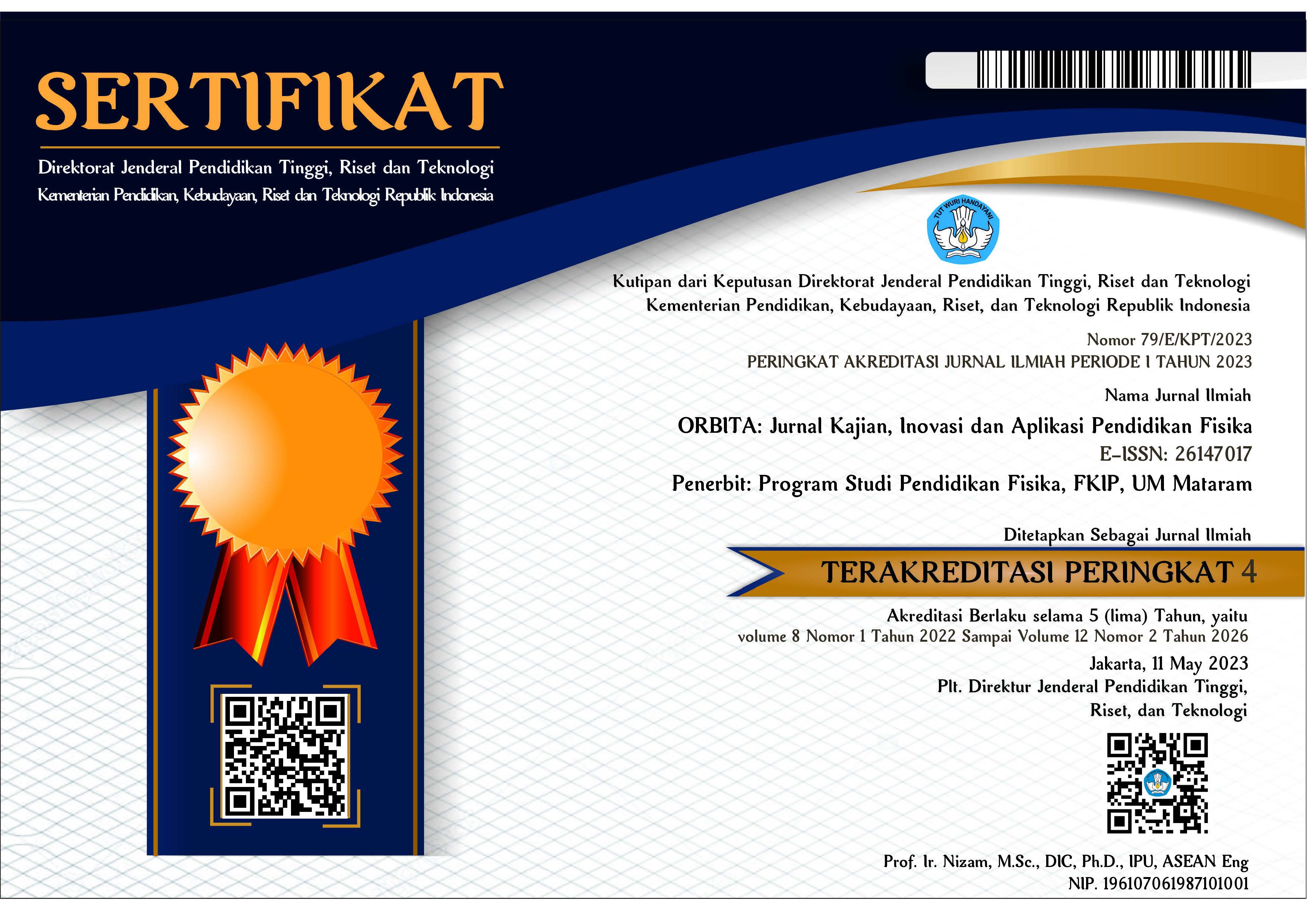SINTESIS DAN KARAKTERISTIK SIFAT OPTIK SEMIKONDUKTOR ZnO DAN ZnO DOPPING Cu
Abstract
ABSTRAK
Telah dilaksanakan penelitian ZnO dan ZnO doping tembaga yang bertujuan untuk mengetahui sifat optik material tersebut meliputi nilai absorbansi dan celah pita energi. Penelitian ini diselesaikan dengan menggunakan metode liquid phase deposition atau kimia basah yang dilakukan dengan konsentrasi tembaga 0 dan 11%, selanjutnya dilakukan pemanasan pada microwave kemudian dikarakterisasi nilai absorbansi dan energi gap dengan spektrofotometri UV-VIS. Hasil yang diperoleh pada penelitian ini adalah ZnO:Cu 0% dan 11% memiliki serapan paling tinggi berada disekitar panjang gelombang 344 nm dan 358 nm, Setelah menentukan nilai absorbansinya kemudian menganalisis nilai celah pita energi dengan konsentrasi 0% dan 11% diperoleh nilai celah pita energi secara berurutan yaitu 3.37 eV dan 3.31 eV. Penambahan doping Tembaga mengakibatkan puncak absorbansi bergeser kearah panjang gelombang yang lebih besar. Sehingga dapat dikatakan bahwa bahwa ZnO:Cu baik 0% maupun 11% merupakan karakterisaasi bahan yang dapat mengabsorbsi cahaya UV.
Kata kunci: semikonduktor; sifat optik; absorbansi; celah pita energi.
ABSTRACT
Research has been carried out on copper doped ZnO and ZnO which aims to determine the optical properties of these materials including absorbance values and energy band gaps. This research was completed using the liquid phase deposition method or wet chemistry which was carried out with copper concentrations of 0 and 11%, then heating in the microwave and then characterizing the absorbance value and energy gap by spectrophotometry UV-VIS. The results obtained in this study are ZnO:Cu 0% and 11% have the highest absorption around the wavelengths of 344 and 358 nm. After determining the absorbance value, then analyzing the energy band gap value with a concentration of 0% and 11%, the energy band gap values obtained respectively are 3.37 eV and 3.31 Ev. The addition of copper doping causes the absorbance peak to shift towards a larger wavelength, So it can be said that ZnO:Cu both 0% and 11% is a characterization of materials that can absorb UV light.
Keywords: semiconductors; optical properties; absorbance; energy gap.
Keywords
Full Text:
PDFReferences
Ali, A. M., Ismail, A. A., Najmy, R., & Al-Hajry, A. (2014). Preparation and characterization of ZnO–SiO2 thin films as highly efficient photocatalyst. Journal of Photochemistry and Photobiology A: Chemistry, 275, 37-46.
Astuti, B., Marwoto, P., Zhafirah, A., Hamid, N., Aryanto, D., Sugianto, S., . . . Fianti, F. (2021). Structure, morphology, and optical properties of ZnO: Mg thin film prepared by sol-gel spin coating method. Jurnal Ilmiah Pendidikan Fisika Al-Biruni, 10(2), 75-84.
Chen, C.-N., Wang, J.-Y., & Huang, J.-J. (2019). Titanium oxide hollow structure layer for dye sensitized solar cell by liquid phase deposition. SN Applied Sciences, 1(10), 1-8.
Lam, S.-M., Sin, J.-C., Abdullah, A. Z., & Mohamed, A. R. (2012). Degradation of wastewaters containing organic dyes photocatalysed by zinc oxide: a review. Desalination and Water Treatment, 41(1-3), 131-169.
Luo, C.-Q., Ling, F. C.-C., Rahman, M. A., Phillips, M., Ton-That, C., Liao, C., . . . Djurišić, A. B. (2019). Surface polarity control in ZnO films deposited by pulsed laser deposition. Applied Surface Science, 483, 1129-1135.
Ma, T. (2021). Effect of precursor concentration and sintering on functional properties of ZnO thin films deposited by aerosol-assisted chemical vapour deposition (AACVD). Materials Science in Semiconductor Processing, 121, 105413.
Mandar, S., & Zainul, R. (2019). SINTESIS DAN KARAKTERISASI NANO ZnO DOPING CU. Periodic, 8(1), 20-23.
Ningsih, S. K. W., Khair, M., & Veronita, S. (2021). Synthesis and Characterization of ZnO Nanoparticles Using Sol-Gel Method. Indonesian Journal of Chemical Science, 10(1), 59-67.
Pung, S., Ong, C., Isha, K. M., & Othman, M. (2014). Synthesis and characterization of Cu-doped ZnO nanorods. Sains Malaysiana, 43(2), 273-281.
Saragih, A. D., Abdullah, H., & Kuo, D.-H. (2019). Study On The Doping Effect Of Cu-Doped ZnO Thin Films Deposited By Co-Sputering Technique. Paper presented at the Journal of Physics: Conference Series.
Saravanakkumar, D., Sivaranjani, S., Kaviyarasu, K., Ayeshamariam, A., Ravikumar, B., Pandiarajan, S., . . . Maaza, M. (2018). Synthesis and characterization of ZnO–CuO nanocomposites powder by modified perfume spray pyrolysis method and its antimicrobial investigation. Journal of semiconductors, 39(3), 033001.
Sulhadi, S., Fatiatun, F., Marwoto, P., Sugianto, S., & Wibowo, E. (2015). Variasi Suhu Deposisi Pada Struktur, Sifat Optik Dan Listrik Film Tipis Seng Oksida Dengan Doping Galium (ZnO: Ga). Jurnal Pendidikan Fisika Indonesia, 11(1), 93-99.
DOI: https://doi.org/10.31764/orbita.v8i1.8406
Refbacks
- There are currently no refbacks.

This work is licensed under a Creative Commons Attribution-ShareAlike 4.0 International License.
______________________________________________________
ORBITA: Jurnal Pendidikan dan Ilmu Fisika
p-ISSN 2460-9587 || e-ISSN 2614-7017
This work is licensed under a Creative Commons Attribution-ShareAlike 4.0 International License.
EDITORIAL OFFICE:


























